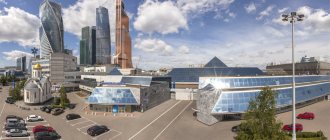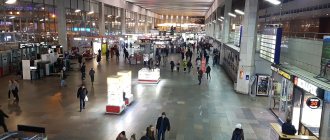General provisions
1.1.
The policy regarding the processing of personal data (hereinafter referred to as the Policy) is aimed at protecting the rights and freedoms of individuals whose personal data is processed by Podzemny Expert LLC, hereinafter referred to in the text as the Operator. 1.2. The policy was developed in accordance with clause 2, part 1, art. 18.1 of the Federal Law of July 27, 2006 No. 152-FZ “On Personal Data” (hereinafter referred to as the Federal Law “On Personal Data”).
1.3. The Policy contains information subject to disclosure in accordance with Part 1 of Art. 14 Federal Law “On Personal Data”, and is a publicly available document.
1.4. The policy states:
- purposes of processing personal data;
- grounds for processing personal data;
- categories of personal data subjects;
- terms of processing and storage of personal data;
- transfer of personal data to third parties;
- information about the processing and security of personal data;
- rights of personal data subjects.
1.5. The operator operates at the address: 192102, St. Petersburg, Fuchika street, no. 4, lit. K, room 16N.
1.6. Olga Evgenievna Korotkova (phone 8(812)3250565, e-mail) was appointed responsible for organizing the processing of personal data.
What not to do on the Tokyo subway
We advise you not to board the ladies' carriage in the morning if you are a man. The surrounding girls, rushing to work, will not like this. This car is pink, including stickers on the windows indicating its ownership in Japanese and English.
On trains, try to occupy one passenger seat and never place bags on the next seat. Don’t sit on the floor, don’t eat in the carriage, don’t stretch your legs and (dear ladies, we’re talking to you!) don’t cross your legs. Such little things can give rise to international conflict. Remember the most important thing: silent mode on your phone and no phone conversations during the trip. By the way, avoid standing girls in stiletto heels. They rarely hold on to the handrails and, if the carriage rocks, they may well break your toe with their stilettos. However, the Japanese rarely hold on to the handrails, but men do less harm here.
Terms and definitions used
2.1. Personal data - any information relating to a directly or indirectly identified or identifiable individual (subject of personal data).
2.2. Operator - a state body, municipal body, legal or natural person, independently or jointly with other persons organizing and (or) carrying out the processing of personal data, as well as determining the purposes of processing personal data, the composition of personal data to be processed, actions (operations) performed with personal data.
2.3. Processing of personal data - any action (operation) or set of actions (operations) performed using automation tools or without the use of such means with personal data, including collection, recording, systematization, accumulation, storage, clarification (updating, changing), extraction, use, transfer (distribution, provision, access), depersonalization, blocking, deletion, destruction of personal data.
2.4. Providing personal data - actions aimed at disclosing personal data to a certain person or a certain circle of persons.
2.5. Destruction of personal data - actions as a result of which it becomes impossible to restore the content of personal data in the personal data information system and (or) as a result of which material media of personal data are destroyed.
2.6. Blocking of personal data is a temporary cessation of processing of personal data (except for cases where processing is necessary to clarify personal data).
Ticket types and prices
Tourists who come to Tokyo for a short period of time usually use regular tickets . You can buy them from ticket machines. The cost depends on the length of the routes (prices for children's tickets are indicated in brackets):
- 1–6 km – 1.75 dollars/170 (90) yen,
- 7–11 km – 2 dollars/200 (100) yen,
- 12-–19 km – 2.35 dollars/240 (120) yen,
- 20–27 km – 2.75 dollars/280 (140) yen,
- 28–40 km – $3.05/310 (160) yen.
In addition to this type of ticket, you can consider purchasing prepaid travel pass (IC card). What is good about it in my opinion? Firstly, it will give you a small discount on each trip. Secondly, and this is the main thing, it will save time. When entering and exiting the metro, the card is applied to the turnstile scanners, which automatically process the payment. You can buy the card in offices or at vending machines; its second big advantage is that it is refillable.
For those who travel with a large group, in my opinion, it makes sense to purchase Coupon Tickets - ticket books . A standard book will give you a 10% savings.
Other types of tickets, such as student or transfer tickets, are designed mainly for those who permanently reside in Tokyo, they are unlikely to be useful during a short trip.
Purposes of processing personal data
3.1. The operator processes personal data for the following purposes:
3.1.1. for the execution of a contract to which the subject of personal data is a party;
3.1.2. establishing feedback for processing incoming requests from individuals for the purpose of providing information and consulting services, advertising services, including sending notifications and requests;
3.1.3. to promote the Operator’s information services on the market by making direct contacts with the subject of personal data using communication means;
3.1.4. conducting personnel work and organizing records of the Operator’s employees;
3.1.5. attracting and selecting candidates to work for the Operator;
3.1.6. identification of a visitor to the Operator’s website – https://undergroundexpert.info/;
3.1.7. providing website visitors with information about the company and the services provided;
3.1.8. to achieve the goals provided for by an international treaty of the Russian Federation or law, to implement and fulfill the functions, powers and responsibilities assigned by the legislation of the Russian Federation to the Operator;
Grounds for processing personal data
4.1. The legal basis for the processing of personal data is:
4.1.1. Legislation of the Russian Federation in the field of personal data
based on the Constitution of the Russian Federation and international treaties of the Russian Federation and consisting of Federal Law of July 27, 2006 No. 152-FZ “On Personal Data” and other federal laws defining cases and features of the processing of personal data;
4.1.2. consent to the processing of personal data, the conditions of which are confirmed
by the subject of personal data in writing, when working with the feedback form on the Operator’s website, when using the Operator’s website;
4.1.3. any agreements concluded by the Operator, annexes to these agreements.
And what kind of free lunch can you get?
The press service of the metro said that if 2,000 people register in the program, then coupons for tempura rolls will be issued, if 2,500 people - coupons for funchose, and if more than 3,000 people register in the program, then the winners will be able to receive even , and other. The metro service also provided a list of four restaurant chains where metro users can redeem coupons.
WHO recommends vaccination against COVID-19 for mild cases
The star of “Univer” spoke about the trial with producer Viktor Drobysh
Miners began making farms from gaming laptops: up to $70 thousand in profit per year
Terms of processing and storage of personal data
6.1. The processing of personal data is terminated by the Operator upon achievement of the goals of such processing, as well as upon expiration of the period provided for by law, contract, or consent of the subject of personal data to the processing of his personal data. When the subject of personal data withdraws consent to the processing of his personal data, processing is carried out only to the extent necessary for the execution of contracts concluded with him and for the purposes provided for by the legislation of the Russian Federation.
Transfer of personal data to third parties
7.1. To achieve the purposes of processing personal data and with the consent of the subjects of personal data, the Operator provides personal data or entrusts their processing to the following persons:
7.1.1. government agencies;
7.1.2. individuals who are in labor and civil relations with the Operator's counterparties;
7.1.3. to individuals who are in labor and civil legal relations with the Operator.
7.2. In order to fulfill contractual obligations or requirements of federal law, the Operator receives personal data from the following third parties:
7.2.1. Other persons in accordance with a civil law agreement.
7.3. The processing of personal data is carried out in compliance with confidentiality, which means the obligation not to disclose to third parties or distribute personal data without the consent of the subject of personal data, unless otherwise provided by the legislation of the Russian Federation.
Information about the processing of personal data
8.1. The Operator processes personal data on a legal and fair basis to fulfill the functions, powers and duties assigned by law, to exercise the rights and legitimate interests of the Operator, the Operator’s employees and third parties.
8.2. The operator receives personal data directly from the subjects of personal data.
8.3. The operator processes personal data in automated and non-automated ways, with and without the use of computer technology.
8.4. Actions for processing personal data include collection, recording, systematization, accumulation, storage, clarification (updating, changing), extraction, use, transfer (distribution, provision, access), depersonalization, blocking, deletion and destruction.
8.5. Databases of information containing personal data of citizens of the Russian Federation are located on the territory of the Russian Federation.
8.6. The operator has the right to entrust the processing of personal data to another person with the consent of the subject of personal data, unless otherwise provided by federal law.
Such processing of personal data is carried out only on the basis of an agreement concluded between the Operator and a third party, which must define:
- a list of actions (operations) with personal data that will be performed by a third party processing personal data;
- purposes of processing personal data;
- obligations of a third party to maintain the confidentiality of personal data and ensure their security during processing, as well as requirements for the protection of processed personal data.
Information about ensuring the security of personal data
9.1. The operator appoints a person responsible for organizing the processing of personal data to fulfill the duties provided for by the Federal Law “On Personal Data” and the regulatory legal acts adopted in accordance with it.
9.2. The operator applies a set of legal, organizational and technical measures to ensure the security of personal data to ensure the confidentiality of personal data and their protection from unlawful actions:
9.2.1 provides unlimited access to the Policy, a copy of which is posted on the Operator’s website at https://undergroundexpert.info;
9.2.2 in pursuance of the Policy, approves and puts into effect internal local acts;
9.2.3 familiarizes employees with the provisions of the legislation on personal data, as well as the Policy and internal local regulations;
9.2.4 provides access to employees to personal data processed in the Operator’s information system, as well as to their material media only for the performance of job duties;
9.2.5 establishes the rules for access to personal data processed in the Operator’s information system, and also ensures registration and accounting of all actions with it;
9.2.6 assesses the harm that may be caused to personal data subjects in the event of a violation of the Federal Law “On Personal Data”;
9.2.7 identifies threats to the security of personal data during their processing in the Operator’s information system;
9.2.8 applies organizational and technical measures and uses information security tools necessary to achieve the established level of personal data security;
9.2.9 detects facts of unauthorized access to personal data and takes response measures, including restoration of personal data modified or destroyed due to unauthorized access to it;
9.2.10 carries out internal control of compliance of the processing of personal data with the Federal Law “On Personal Data”, regulations adopted in accordance with it, requirements for the protection of personal data, Policy, Regulations and other local acts, including control over measures taken to ensure the security of personal data and their level of security when processed in the Operator’s information system.
Why were such drastic measures required?
Getting free funchoza and rolls for riding the subway before rush hour can be much easier in Tokyo than finding an empty seat. Tokyo's busiest subway line is Totsai, according to Nippon.com, citing a 2021 report by the city's transit authority. According to the same website, the congestion level of this Tokyo metro line reaches 199% - and there are no free seats on this scale even when the metro lines are 100% congested. The condition, which is expressed by the figure of 199% occupancy, is described in government sources as a condition when "the bodies of passengers are so close to each other that the person feels noticeable pressure."
About a thousand enterprises and firms met the needs of Tokyo metro employees and moved the opening hours for their workers to before rush hour. Just for reference, during rush hour between 7:50 and 8:50 a.m. alone, the Totsai line is used by 7,600 people—twice as many as the line and its trains were designed to use.
Rights of personal data subjects
10.1 The subject of personal data has the right:
10.1.1. to receive personal data relating to this subject and information regarding their processing;
10.1.2. to clarify, block or destroy his personal data if they are incomplete, outdated, inaccurate, illegally obtained or are not necessary for the stated purpose of processing;
10.1.3. to revoke his consent to the processing of personal data;
10.1.4. to appeal the actions or inaction of the Operator to the authorized body for the protection of the rights of personal data subjects or in court.
10.1.5. To exercise their rights and legitimate interests, subjects of personal data have the right to contact the Operator by sending personally or with the help of a representative a request containing the information specified in Part 3 of Art. 14 Federal Law “On personal data at the address specified in paragraph 1.5 of this Policy.
“The Tokyo metro is like the Purple Line at rush hour”: what the subways of other countries can surprise
The Moscow metro is called one of the most beautiful in the world. The capital's subway stations, built in the center of Moscow, still surprise foreign tourists. But in addition to the cinematic stations, they are struck by the scale of the lobbies, the noise on the trains and curious passengers. A RIAMO observer asked foreigners and former fellow citizens who moved to Japan, the USA, South Korea and Portugal how their metro works and how it differs from Moscow.
Marcio, 36 years old, artist, Lisbon:
pixabay.com
“The Lisbon metro is very clean, some stations are decorated with typical ceramic tiles with images of artists’ paintings. One of the most famous stations is Olaias, which has repeatedly been included in the ratings of the most beautiful in the world. This depicts the nature of the areas where olive trees grow. But the metro in Lisbon is not as in demand as in Moscow. And the intervals between trains are longer than in Moscow. Use it only if you need to get to distant stations.
When I first arrived in Moscow, it seemed to me that the Moscow metro was very noisy and had a specific smell. That is, it is impossible to talk in carriages. I was also surprised by the intrusiveness of the passengers. There was such a case. We went into the Moscow metro with a Russian girl and sat next to some guys. They turned out to be drunk. One of the guys started looking at my girlfriend, and then said to her: I like your boyfriend’s glasses, will he let me try them on? I replied that I don’t speak Russian.
The guy was delighted: “Oh, a foreigner!!! Where? Portugal??? Cristiano Ronaldo!!!! Let's take a photo!"
I refused, and the drunk passenger calmed down a little, but continued to carefully examine us. Across the station, he began to obsessively offer us nuts and did not stop until we took a few. Across the station he said goodbye and shook my hand! “Bye, bro,” the drunk passenger told me.”
Catch me if you can: where is the best mobile Internet in the metro>>
Igor, 52 years old, banking analyst, New York:
pixabay.com
“I have lived in the USA for 25 years and am used to the New York subway. Unlike the Moscow metro, where a beginner can quickly find his way around, in New York a tourist needs to know some features. Trains from different lines and directions arrive at the same platform, and you have to be careful, otherwise you will end up somewhere in the Bronx instead of Manhattan. In addition, there are two types of trains in the subway - express and regular, and express trains also depart from a common platform.
You get on an express train, travel part of the way without stopping, and then transfer to a regular train, which stops at the stop you need.
Payment is made by card, which you present to the validator at the entrance and exit. The required amount is written off - if there is not enough money, you simply will not leave the station.
It must be said that the subway is the fastest way to get to Manhattan, where wealthy Americans work. But even they are not ready to pay $20 an hour for parking, and even stand in traffic jams.
Therefore, they go to work by car, leave it at an intercept parking lot near the metro, and then they have two options. If you have time, take a taxi. If time is short, you have to go underground. Therefore, in the evening there are a lot of rich people in the metro, and also crime. The New York subway cannot be called safe, although order has been restored in recent years. Can't compare with what it was 20 years ago. In general, the public on the subway reflects all segments of American society - both the marginalized and the very rich use it.”
“Shut-up”, “pillars” and scooters: who is annoying in the Moscow metro>>
Sergey, 28 years old, financial director, London:
pixabay.com
“For many Moscow tourists, the London Underground seems familiar, but, in my opinion, it is very different. In the London metro, the carriages are narrower than the usual ones in Moscow, and instead of plastic seats there are soft sofas, which seems completely impractical to me.
In my subjective opinion, the layout of the London underground is more difficult to understand, in contrast to the usual layout of the Moscow metro.
I don't think there's any logic to their grid-like design.
London Underground stations have historical names. Among them is the Sherlock Holmes station, where the walls are painted with texts from stories about the detective who showed the world the powers of deduction, and are decorated with illustrations.
I don’t know how it is in Moscow now, but there are a lot of migrants in the London metro. Rumor has it that there are rats in the subway, but I haven't seen them. Although I can easily believe it.
But in Munich, where I often go for work, the metro is similar to Moscow. The average age of the carriages there is perhaps fifteen years. And very clean. Everything is done with taste. Only in the carriages there is a mixed arrangement of seats - the benches, like in electric trains, are placed opposite each other. The cars in the Munich metro are wider. This surprised me, I always thought that the Moscow subway cars are the widest in the world.”
“You feel like you’re in heaven” - passengers about the Solntsevskaya metro line>>
Alexander, 56 years old, entrepreneur, Shanghai:
pixabay.com
“I will never forget my first ride on the Shanghai Maglev - a magnetic levitation train - from Pudong Airport to the Shanghai Metro on my first arrival. Impressed is not the right word.
Unlike the Moscow metro, for an unprepared person, the Shanghai metro is a quest.
Although there is a well-thought-out security and orientation system. The metro lines on the map are painted in different colors and numbered. Navigation on the floor - arrows in bright neon color.
My first time on the Shanghai subway, without knowing Chinese, I would definitely have gotten lost. The inscriptions in English are not duplicated everywhere. It is difficult to hear the names of stations in Chinese. A special mobile application helps out. You plot the route and follow it on your smartphone and on the illuminated information board in the carriage.
The design of the Shanghai metro is much simpler than the pompous Moscow one. Some of our monumental metro stations are decorated with marble and look like palace halls, where passengers ended up as if by chance.
The Shanghai metro looks more like a shopping mall, dominated by dull, cheap tiles.
The fare depends on the duration of trips and the number of stations. There are payment machines at the entrance. Some require coins, others can be paid using a smartphone.
People in the Shanghai metro, as in the Moscow metro, almost never look their fellow traveler in the eye. All passengers are on their phones. And they do not behave as intelligently as, for example, in the Novosibirsk or St. Petersburg metro. During rush hour at Shanghai stations, a screaming crowd can rush into the carriage, pushing each other aside to get a comfortable seat. That's why I prefer to travel around Shanghai by taxi. At the same time, I’m looking at my favorite city.”
Muscovites about the Filevskaya metro line: a quest for foreigners and the best views for selfies>>
Daria Tian, 30 years old, journalist, Seoul:
pixabay.com
“The Seoul metro is considered the safest and most comfortable in the world. There are very clear diagrams and convenient transitions from one branch to another. The carriages are equipped with air conditioning that automatically turns on at a certain temperature or number of people. Stops are always announced in three languages - Korean, English, Chinese and sometimes Japanese. Like the Moscow metro, Seoul has seats for elderly passengers and pregnant women.
But there is a peculiarity - older people do not use the metro during rush hour, since this is working class time.
Just like in Moscow, in Seoul the metro is the fastest way to travel, and even popular artists use it. The carriages are clean and quiet. There is no unpleasant smell in the subway. There are a lot of branches, but it won’t be difficult for Moscow residents to understand them. Another plus is that the Seoul subway has a free toilet.”
Muscovites about the BKL metro: quests with trains, “soulless” stations and elite passengers>>
Dmitry, 40 years old, programmer, Tokyo:
pixabay.com
“When I first flew to Tokyo, I was amazed that all the passengers read comics, not books like in Moscow. This was 20 years ago. Now, like in Moscow, everyone here is on gadgets.
In terms of crowding, the Tokyo subway can be compared to the Purple Line at rush hour - there are so many people that special employees in white gloves and red caps politely but confidently push people into the carriages.
Navigation there is not very convenient for a foreigner, even one who speaks fluent English. The inscriptions are duplicated, but if you get lost and contact a local resident in English or German, they will not answer you. And not because they didn’t understand - the Japanese have an excellent command of languages. They are simply embarrassed by their pronunciation.
There is only one piece of advice in this situation: if you have gone in the wrong direction, look for a metro employee in white gloves, he will be the one who will help you.
It's easy to get lost here. Because trains from different directions arrive on the same platform. And when the train emerges from the tunnel to the surface, it is difficult to understand: this is still a metro, or already an electric train, or a city tram. The Tokyo metro is very extensive, but if you look at the map, not a single line crosses the city center. And all because in the center of Tokyo there is a palace of the Japanese emperor with a large garden around it. You can't ride over his head. That's why all the metro lines meander in the most bizarre way.
Within Greater Tokyo there are several multi-tiered metro terminals that are similar in function to our train stations. The metro runs below, and high-speed trains depart from the upper tiers to other parts of the country. Therefore, there is no need to transfer anywhere. If a passenger needs to get, for example, to Osaka, he simply goes up the escalator and goes to the level where high-speed trains run in the direction he needs.
The fare is calculated depending on the duration of the trip. You just need to touch the card to the device twice - at the entrance and exit, and the required amount will be debited from it. Another feature of the Tokyo metro is that trains belonging to different companies travel along this extensive common infrastructure. And, surprisingly, no one violates the schedule!”









